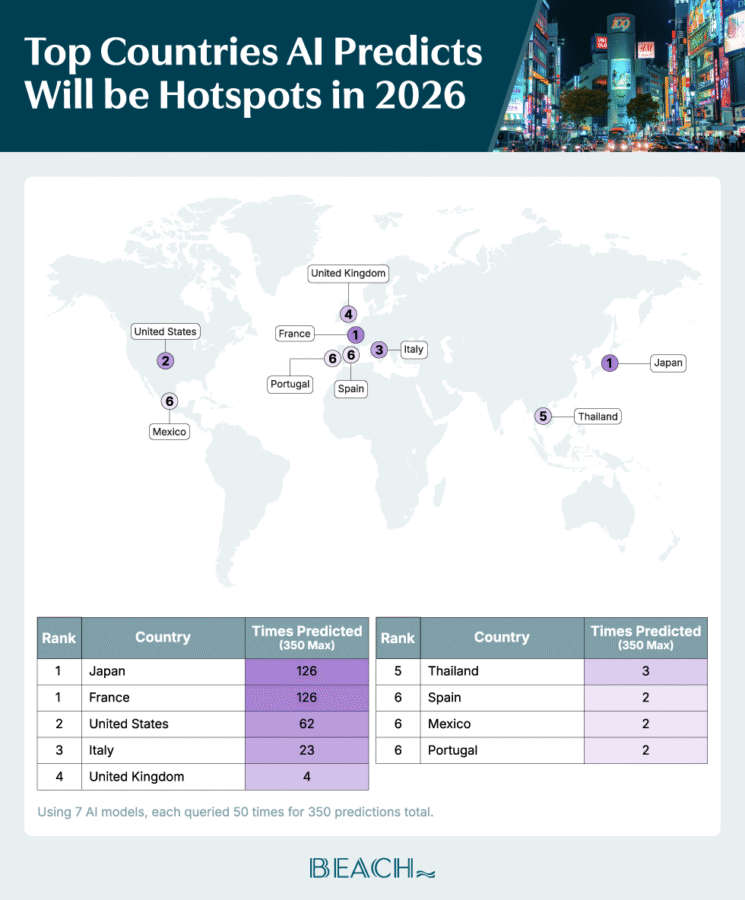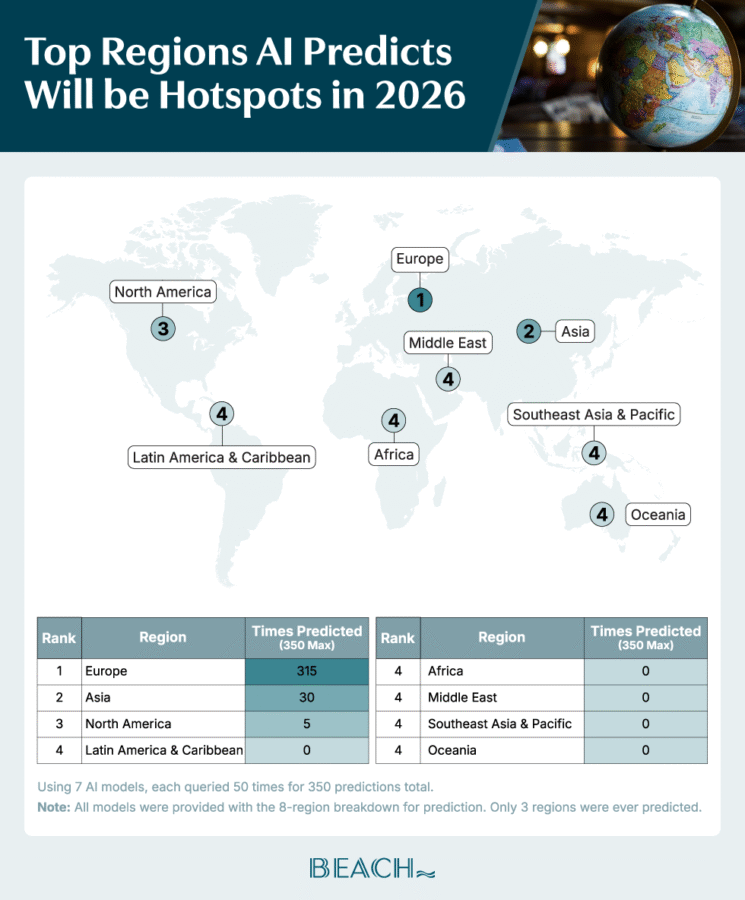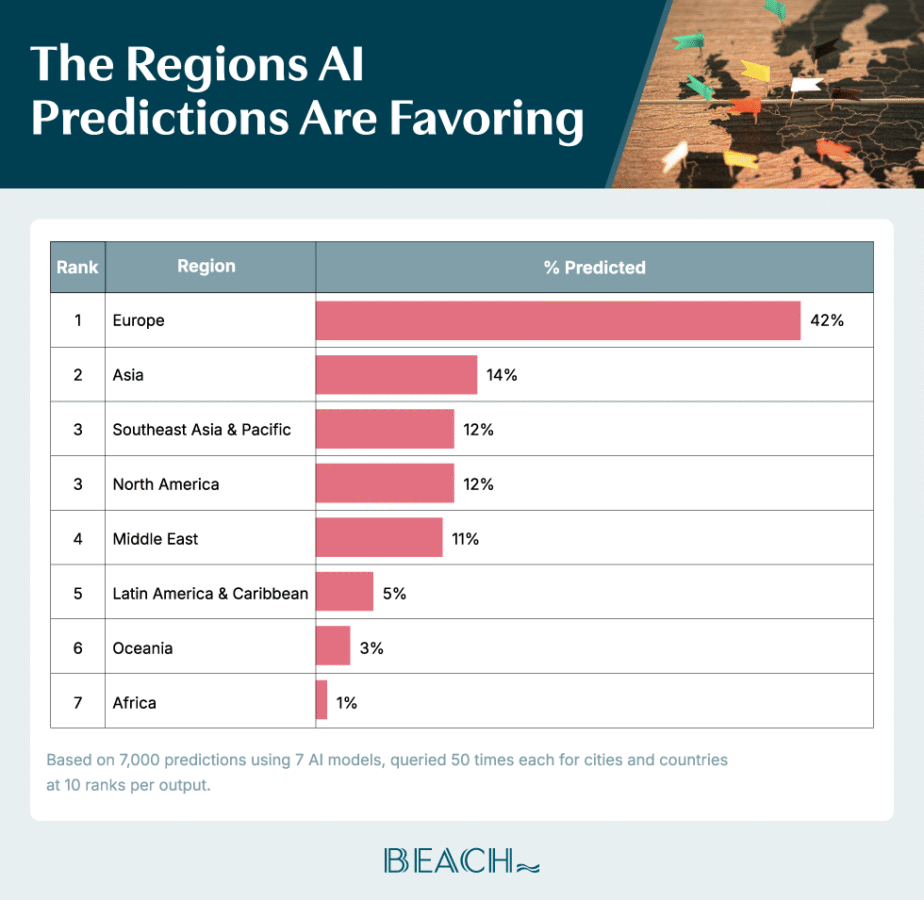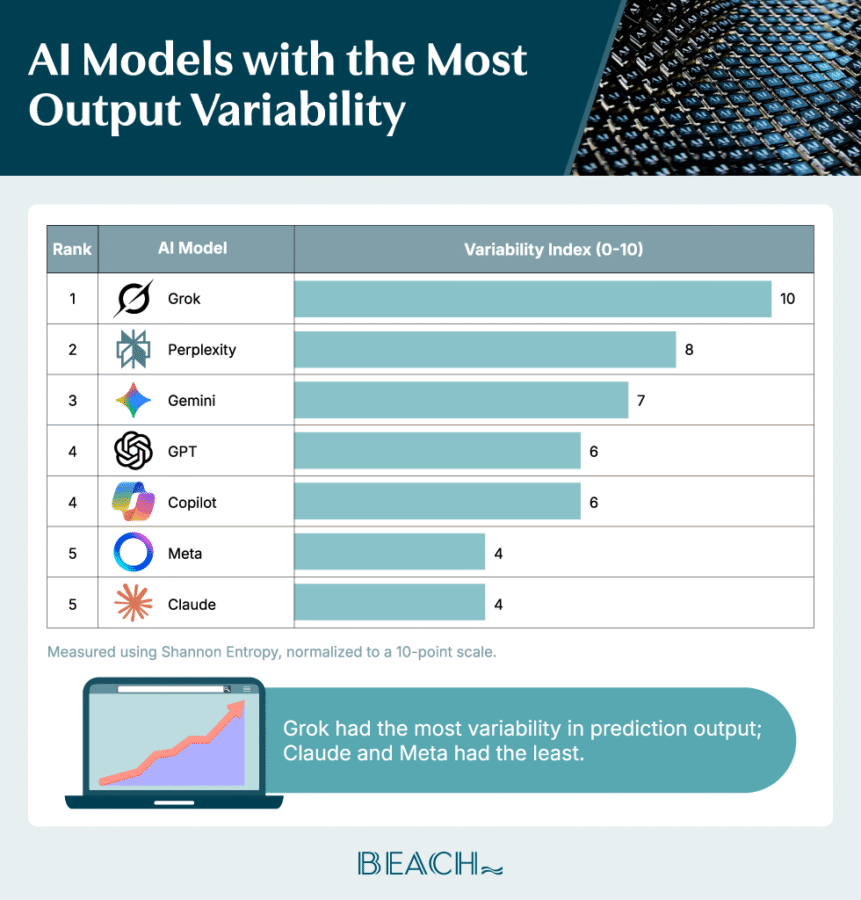Artificial intelligence (AI) is already shaping travel plans, but can it forecast the next top travel destinations? A new analysis by Beach.com uncovers that the seven most popular generative AI models “think” Europe will be the epicenter of travel in 2026.
We asked ChatGPT, Google Gemini, Perplexity, Claude by Anthropic, Meta AI, Grok, and Microsoft Copilot to predict which destinations will be global travel hotspots in 2026. We didn’t just ask once; we ran 50 prompts per model for a total of 9,800 destination predictions. Our insights reveal which cities, countries and regions generative AI predicts travelers will be flocking to in 2026. Or perhaps these are the destinations that generative AI will also be suggesting travelers visit most.
These findings build on our emerging research about how AI tools are shaping trip planning. With over two-thirds of Americans already using AI to plan travels, read on to find out where AI thinks everyone will be going in 2026!
Table of Contents
Key Findings
- Across 7 AI tools, Paris is the most predicted city hotspot for 2026, ranking #1 in 124 of 350 queries.
- Japan and France tied for the most predicted country hotspot, each ranking #1 in 126 of 350 queries.
- Europe is the most predicted region hotspot, ranking #1 in 315 of 350 queries.
- 42% of predicted city and country hotspots were in Europe, 14% in Asia, 12% in Southeast Asia & the Pacific and 12% in North America.
AI Forecasts the Cities That Will be Trending in 2026
If the seven most-popular generative AI models have any predictive power, 2026 could belong to Paris. We asked each model to predict the #1 2026 city travel hotspot 50 times, for a total of 350 predictions. Paris dominated the forecasts, finishing first in 124 of the 350 model runs, or 35%.

No other city came close to Paris. Tokyo trails in a distant second place, landing #1 in 94 forecasts (27%). With nearly half the predictions of Tokyo, London takes third place by landing first in 48 predictions. Bangkok is close behind in fourth place by taking first in 36 predictions.
All of the top-ranking cities fall into a mix of classical cultural hubs and fast-paced megacities. Similarly, many of the predicted top travel destinations are also among the world’s most visited.
AI Forecasts the Countries That Will be Trending in 2026
We also asked the seven AI models to predict the #1 country destination in 2026. At the country level, the models produced a tie. AI predicts Japan and France tie for the #1 country destination. Both countries came out on top 126 times (36% each). With only 350 total forecasts, only a few top spots are for other countries.

Coming in with less than half the amount of France or Japan, the U.S. ranks second. AI models predict it to be one of the top travel destinations only 62 times (18%). With less than one-fifth the predictions of France or Japan, Italy, landing the top prediction only 23 times (7%), comes in at a very distant third place.
However, the models predicted Italy as the top country over 5X the United Kingdom. Models forecast the United Kingdom as the top destination 4 times, or 1%. Thailand lands three predictions, and models predict Spain, Mexico and Portugal as the top countries only twice.
Clearly, generative AI leans heavily toward longstanding cultural destinations with robust existing infrastructure and a strong tourism history. It’s also worth noting that these destinations are among the most well-covered online.
AI Forecasts the Regions That Will be Trending in 2026
The countries AI models predict will be the top travel destinations in 2026 seem clear-cut. However, the world regions AI forecasts to be the top travel destinations are even more one-sided. Europe dominates the forecasts. All seven AI models predict the region to be the #1 destination a whopping 315 out of 350 times. That’s 90% of all forecasts!

With Europe taking the lion’s share, the remaining regions of the world only share 35 predictions. In fact, there is hardly any “sharing” of the remaining 35 predictions. AI predicts Asia as the top region 30 times and North America five times.
Latin America & the Caribbean, Africa, the Middle East, Southeast Asia & the Pacific, and Oceania all received zero predictions. What is striking is that we gave all AI models this eight-region breakdown in each prompt. This means models weren’t arbitrarily picking regions out of thin air, but from a specific list of eight regions.
The absence of these other regions in any #1 prediction could suggest a strong algorithmic bias toward destinations with the most robust representation in online travel media. As with the cities and countries AI predicts will be the #1 destinations, Europe and Asia are among the most well-covered regions in online media.
What’s interesting is that the AI models not only predicted Europe as the major regional hotspot for 2026, but also that a plurality of the forecasted top cities and countries fell within this region. In other words, there is some continuity in the destinations AI models favor, even when we adjust the questions.

Across the 7,000 total city and country predictions, 42% are in Europe, or 2,940 destinations. Only 14% (980 destinations) are in Asia. Another 12% (840 destinations) each are in Southeast Asia & Pacific and North America. The Middle East accounts for roughly 1 in 10 forecasts (11%). Latin America & the Caribbean had 350 cities and countries (5%). Oceania accounts for just 3% (210 destinations) of all forecasts, and Africa for just 1% (70 destinations).
These results beg the question: does the sheer volume of travel content for these cities, countries and regions that rank #1 directly influence the AI models’ predictions? Are these models forecasting demand, or are they just reinforcing the destinations they “know” best by drawing on the overwhelming amount of existing content covering the regions the AI models favor?
AI Model Forecast Differences
Until now, we’ve been speaking of the seven AI models as a monolith. Although Europe dominated regional forecasts across all AI models, there were significant divergences in the city and country predictions.
At the individual city-prediction model level, both Claude and Gemini forecasted Paris as #1. That’s the same city that panned out #1 study-wide. Meta and Copilot predicted Tokyo as #1, which came out #2 in the study. Perplexity was the only model to put London as the #1 city travel hotspot for 2026. London landed #3 overall. ChatGPT predicted Bangkok as #1, which panned out to #4 in the study. Grok gravitated toward Milan, which landed #5.
County-level forecasts at the model level are a little more consolidated. Claude and Meta ranked France #1 for 2026. Copilot, Gemini and Perplexity predicted Japan. Both these countries tied for the #1 predicted hotspot of 2026. ChatGPT and Grok predicted the U.S., which ranked #2 study-wide. Grok’s country-level predictions also yielded Italy tying with the U.S. for Grok’s #1 prediction. Italy was #3 across the study.
Despite the variations, all the cities and countries each model predicted to be the top travel destinations are in the study’s top five spots. On top of that, all seven models reached a unanimous conclusion. Every AI system predicts Europe as the top region for 2026.
We’ve looked at the AI model outputs as a whole and per model. Now, let’s examine the variations within each model. We asked each system to make these predictions 50 times. Some systems varied their answers each time, while others showed near-total consistency.

We measured this variability using Shannon Entropy information theory, using all 147,000 individual destination predictions (21,000 per model). Our goal was to find out how often the models differ in their predictions. We normalized the raw entropy scores to a 10-point index. A score of 10 indicates the greatest variability and 0 the greatest consistency.
Claude and Meta tied for the greatest consistency in their outputs across the 50 prompts. Together, these models predicted the same destinations an average of 44 out of the 50 prompts — that’s an 88% consistency!
Grok, on the other hand, had the greatest variability. This model predicted the same destinations only an average of 29 out of 50 prompts. This means its answers were consistent 58% of the time. Even with this high degree of inter-model variability, the AI with the greatest variability, Grok, still predicted the same destinations over half the time.
Note: We used 147,000 destination predictions in our Shannon Entropy rather than the 9,800 mentioned at the top of the article. This is because we also performed this analysis across 10 traveler types and all four seasons. We will release insights on AI predictions by traveler type and season in future articles. However, we used all destination predictions in our Shannon Entropy-based variability analysis.
Where Will You Go in 2026?
As travelers begin planning for the next year, our AI forecasts offer a look at the destinations that could surge in 2026. Or at least, these are the destinations AI will be possibly recommending most.
Does the overflowing culture of France speak to you? Does the eclectic mix of tradition and innovation of Japan interest you? Or perhaps the U.S.’s big-city energy is attracting you? If you want to turn these AI predictions into destination realities, Beach.com makes it easy to find both trending and hidden gem beach destinations across the globe. Start planning your perfect escape. We forecast a beach vacation in your future!
Sources and Methodology
We used seven popular Generative AI models to predict the destinations that will be travel hotspots in 2026. To do this, we created a prompt containing 3 prediction questions and sent it to each of the seven models 50 times. Within each prompt, we asked the models to predict the cities, countries and regions of the world that will be travel hotspots in 2026. Models were asked to rank their choices from 1 to 10. All responses were collected in a database, standardized, and analyzed using a simple tally method to identify the most common predictions. A total of 9,800 individual destination predictions were made across the 7 AI models.
Click to Expand the Full Methodology
AI Models: The models used in this analysis were selected based on market share. Those models are: ChatGPT, Gemini, Perplexity, Claude, Meta, Grok, and Copilot. Brand-new accounts with no chat history, memory, or other usage were created to handle all queries. The chat history for all 7 models with these new accounts is solely the 50 queries we sent to each model. Free accounts were used for each model, and we selected model features to achieve the most consistent cross-model capabilities.
These specific AI model setups were as follows:
- ChatGPT: Using the free plan, model GPT-5 Thinking Mini (which includes web search), with no additional features.
- Google Gemini: Using the free plan, model 2.5 Pro (which includes web search), with no additional features.
- Perplexity: Using the free plan, “best” model with normal search (no pro), with no additional features. Perplexity’s free plan only lets you choose the “best” model, meaning Perplexity chooses which model to respond with. This means Perplexity may answer using its own model, Sonar, or GPT-5, Claude Sonnet 4.5, Gemini 2.5 Pro or Grok 4. There is no way to know which model is answering the question.
- Claude by Anthropic: Using the free plan, model Sonnet 4.5 with web search turned on and normal style, with no additional features.
- Meta AI: Using the free plan, model Llama 4 (which includes web search), with no additional features.
- Grok: Using the free plan, model Grok 4 Expert (which includes web search), with no additional features.
- Microsoft Copilot: Using the free plan, model Smart (GPT-5, which includes web search), with no additional features. All of Copilot is built on GPT, but Microsoft claims to offer a unique blend of tools, personality and real-time intelligence layered on top of GPT that, according to Microsoft, should set them apart from just using GPT.
The Questions: Each prompt we sent to the AI models contained 3 different questions: the hotspot destinations that AI predicts for 1. Cities 2. Countries and 3. Regions for 2026. For cities and countries, models were asked to provide 10 predictions per question, ranked 1-10 in order of predicted hotspot activity. Within each prompt, models were provided with an 8-region world breakdown and asked to rank those regions 1-8 in order of predicted hotspot activity.
In the prompt, models were told to produce outputs that were copy-paste-friendly in Excel, with comma-delimited code blocks. Answers were directly pasted into our database using a text-to-table function. Responses were organized in one row per question, with the model that answered, the query number, the category, and all 10 ranks (8 for regions). See the “Click to Expand the Full AI Prompt” line at the bottom of this methodology for the full AI prompt we sent to each model.
The Numbers: In total, 350 prompts were sent across the 7 AI models. With 3 questions per prompt, the models answered a combined 1,050 questions. At 10 ranks per city and country and 8 per region, a total of 9,800 individual predictions were made.
Standardization: All city, country, and region responses were standardized for consistency. I.E., UK, U.K., and United Kingdom became United Kingdom. St. Barts, St Barts, Saint Barts, St. Barths, St Barth’s became Saint Barthélemy. Other character formatting issues were also cleaned, such as random parentheses, hyphens, spaces, commas and more.
Any hallucinatory comments by the AIs “thinking” through prompts were also removed. For example, as a response to a top 10 country question, an AI “thinking” comment could enter results like this: “Patagonia (Wait, user wants countries, not regions) – Chile.” Hallucinations like this were reduced to the final answer. In this case, Chile. Hallucinations, such as suggesting a country rather than a city or a region rather than a country, were not altered in any way. Only name standardization, character correction and “thought process” hallucinatory slips were removed from the collected data.
At times, the AIs did not fully complete a prompt, resulting in missing city, country or regional ranks. In those cases, we did not start a new thread and resend the prompt, but rather prompted the AI within the same thread to provide the missing data by specifically pointing out which ranks were missing. The missing data was added to the first answer, which was counted as one prompt response in our database.
For city suggestions, regarding small regions, especially islands — if an AI suggested a region containing multiple towns, the area was labeled as “not a city” in the database. If the region or area does not contain smaller sub-cities, the suggestion was kept. For example, Koh Chang Island in Thailand does not have a capital or sub-cities, and the suggestion was kept. The country, the Maldives, has multiple cities with a capital, and therefore is marked as “not a city” and not counted in city categories.
Core Analysis: To arrive at our list of the #1 predicted destinations overall, we used a very simple sport-ranking-type panel. We tallied the number of times each location was ranked #1 across all AI models. The locations with the highest tallies are the study’s #1 predicted destinations overall. Each individual prediction is based on 350 total queries across all models. All top travel destinations lists that go beyond the #1 destinations use the same method, with the tallies directly informing their rankings. This method was also used for all per-model rankings.
Regional Analysis: To identify the regions where the proportion of AI predictions fell into, we mapped all unique city and country results to the same 8-region model we used in our prompts. Using Python, 7,000 overall city and country predictions were aggregated by model. We calculated the regional distribution percentage using groupwise normalization via vectorized transformations, ensuring accuracy within each model and across the entire dataset. Regional distributions were calculated for the overall city, overall country, per-model city, and per-model country categories.
Note: The regional analysis is based on all predicted destinations, ranks 1-10, not just the #1 ranks. In other words, the destinations in the city and country data in the above sections are based solely on the destinations AI ranked as #1. However, we had the AI models predict the top 10 destinations, not just the #1. We used all 10 destination ranks (#1-#10) for each model in this regional breakdown.
AI Output Diversity: To evaluate the variability in AI models’ outputs, we quantified it for each model using Shannon entropy information theory. This is a standard metric commonly applied in statistical modeling and data science. It measures the dispersion of our AI outputs. A model that repeatedly predicts the same destinations in each query will have lower entropy. A model that fluctuates widely in predictions per query has higher entropy.
We calculated entropy using each prediction set, by category (1-10 city and country ranks and 1-8 region ranks), as a single separate prediction scenario. We were not interested in how many times a specific model produced the same ordering of predictions, but rather in how often those same predictions were recycled, even with a slightly different ordering. Therefore, each full set of ranks by category was treated as a single distribution. We used Shannon Entropy to quantify the distribution’s spread. We repeated this for all 3 questions for each model across the 50 queries.
Click to Expand the Full AI Prompt
Note: The prompt below contains more than the three questions mentioned above. All questions related to traveler groups or seasons will be covered in future articles. We asked the AI models all questions at once, so the full prompt is provided here for transparency.
Full AI Prompt:
I’m asking you a series of repetitive questions with slight modifications. Follow the prompts, answering each in the order they appear. There are 3 main groups of questions. I’ll ask them for an overall traveler answer, then again for 10 different travel groups, and again for overall travelers for each season. I’m sending you all the questions at once.
Output in a format that is copy-paste-friendly for Excel with comma delimitations, so that when I paste it, the hyphenated words at the start of each question go into column A, one cell per question. I want all your ranks to go in column B onward, one column/cell per rank. I.E., Cell A2: Overall-regions. Cell B2: region rank 1, Cell C2: region rank 2, etc. Cell A3: Overall-cities. Cell B3: cities rank 1, cell C3: cities rank 2, etc. Format the entire answer in a single code block, ensuring no blank rows between lines. Ensure comma delimitation is correct with no spaces before words after a comma.
For all of the region questions, use the following 8-region model:
- North America
- Latin America & Caribbean
- Europe
- Africa
- Middle East
- Asia
- Southeast Asia & Pacific
- Oceania
Overall:
- Overall-regions: Using the common 8-region global model, what regions do you predict will be the biggest travel hotspots in 2026? List all 8 ranked by predicted popularity
- Overall-cities: Out of all the cities in the world, regardless of size or population, what do you predict will be the biggest travel hotspots in 2026? List 10 ranked by predicted popularity
- Overall-countries: Out of all countries in the world, regardless of size or population, what do you predict will be the biggest travel hotspots in 2026? List 10 ranked by predicted popularity
Travel Groups:
- Holidaymakers-regions: Using the common 8-region global model, what regions do you predict will be the biggest travel hotspots for holidaymakers in 2026? List all 8 ranked by predicted popularity
- Holidaymakers-cities: Out of all the cities in the world, regardless of size or population, what do you predict will be the biggest travel hotspots for holidaymakers in 2026? List 10 ranked by predicted popularity
- Holidaymakers-countries: Out of all countries in the world, regardless of size or population, what do you predict will be the biggest travel hotspots for holidaymakers in 2026? List 10 ranked by predicted popularity
- Families-regions: Using the common 8-region global model, what regions do you predict will be the biggest travel hotspots for families in 2026? List all 8 ranked by predicted popularity
- Families-cities: Out of all the cities in the world, regardless of size or population, what do you predict will be the biggest travel hotspots for families in 2026? List 10 ranked by predicted popularity
- Families-countries: Out of all countries in the world, regardless of size or population, what do you predict will be the biggest travel hotspots for families in 2026? List 10 ranked by predicted popularity
- Budget-regions: Using the common 8-region global model, what regions do you predict will be the biggest travel hotspots for budget travelers in 2026? List all 8 ranked by predicted popularity
- Budget-cities: Out of all the cities in the world, regardless of size or population, what do you predict will be the biggest travel hotspots for budget travelers in 2026? List 10 ranked by predicted popularity
- Budget-countries: Out of all countries in the world, regardless of size or population, what do you predict will be the biggest travel hotspots for budget travelers in 2026? List 10 ranked by predicted popularity
- Business-regions: Using the common 8-region global model, what regions do you predict will be the biggest travel hotspots for business travelers in 2026? List all 8 ranked by predicted popularity
- Business-cities: Out of all the cities in the world, regardless of size or population, what do you predict will be the biggest travel hotspots for business travelers in 2026? List 10 ranked by predicted popularity
- Business-countries: Out of all countries in the world, regardless of size or population, what do you predict will be the biggest travel hotspots for business travelers in 2026? List 10 ranked by predicted popularity
- Luxury-regions: Using the common 8-region global model, what regions do you predict will be the biggest travel hotspots for luxury travelers in 2026? List all 8 ranked by predicted popularity
- Luxury-cities: Out of all the cities in the world, regardless of size or population, what do you predict will be the biggest travel hotspots for luxury travelers in 2026? List 10 ranked by predicted popularity
- Luxury-countries: Out of all countries in the world, regardless of size or population, what do you predict will be the biggest travel hotspots for luxury travelers in 2026? List 10 ranked by predicted popularity
- Adventure-regions: Using the common 8-region global model, what regions do you predict will be the biggest travel hotspots for adventure travelers in 2026? List all 8 ranked by predicted popularity
- Adventure-cities: Out of all the cities in the world, regardless of size or population, what do you predict will be the biggest travel hotspots for adventure travelers in 2026? List 10 ranked by predicted popularity
- Adventure-countries: Out of all countries in the world, regardless of size or population, what do you predict will be the biggest travel hotspots for adventure travelers in 2026? List 10 ranked by predicted popularity
- Solo-regions: Using the common 8-region global model, what regions do you predict will be the biggest travel hotspots for solo travelers in 2026? List all 8 ranked by predicted popularity
- Solo-cities: Out of all the cities in the world, regardless of size or population, what do you predict will be the biggest travel hotspots for solo travelers in 2026? List 10 ranked by predicted popularity
- Solo-countries: Out of all countries in the world, regardless of size or population, what do you predict will be the biggest travel hotspots for solo travelers in 2026? List 10 ranked by predicted popularity
- Cultural-regions: Using the common 8-region global model, what regions do you predict will be the biggest travel hotspots for cultural travelers in 2026? List all 8 ranked by predicted popularity
- Cultural-cities: Out of all the cities in the world, regardless of size or population, what do you predict will be the biggest travel hotspots for cultural travelers in 2026? List 10 ranked by predicted popularity
- Cultural-countries: Out of all countries in the world, regardless of size or population, what do you predict will be the biggest travel hotspots for cultural travelers in 2026? List 10 ranked by predicted popularity
- Group-regions: Using the common 8-region global model, what regions do you predict will be the biggest travel hotspots for group travelers in 2026? List all 8 ranked by predicted popularity
- Group-cities: Out of all the cities in the world, regardless of size or population, what do you predict will be the biggest travel hotspots for group travelers in 2026? List 10 ranked by predicted popularity
- Group-countries: Out of all countries in the world, regardless of size or population, what do you predict will be the biggest travel hotspots for group travelers in 2026? List 10 ranked by predicted popularity
- Backpackers-regions: Using the common 8-region global model, what regions do you predict will be the biggest travel hotspots for backpackers in 2026? List all 8 ranked by predicted popularity
- Backpackers-cities: Out of all the cities in the world, regardless of size or population, what do you predict will be the biggest travel hotspots for backpackers in 2026? List 10 ranked by predicted popularity
- Backpackers-countries: Out of all countries in the world, regardless of size or population, what do you predict will be the biggest travel hotspots for backpackers in 2026? List 10 ranked by predicted popularity
Seasons:
- Spring-regions: Using the common 8-region global model, what regions do you predict will be the biggest travel hotspots in Spring 2026? List all 8 ranked by predicted popularity
- Spring-cities: Out of all the cities in the world, regardless of size or population, what do you predict will be the biggest travel hotspots in Spring 2026? List 10 ranked by predicted popularity
- Spring-countries: Out of all countries in the world, regardless of size or population, what do you predict will be the biggest travel hotspots in Spring 2026? List 10 ranked by predicted popularity
- Summer-regions: Using the common 8-region global model, what regions do you predict will be the biggest travel hotspots in Summer 2026? List all 8 ranked by predicted popularity
- Summer-cities: Out of all the cities in the world, regardless of size or population, what do you predict will be the biggest travel hotspots in Summer 2026? List 10 ranked by predicted popularity
- Summer-countries: Out of all countries in the world, regardless of size or population, what do you predict will be the biggest travel hotspots in Fall 2026? List 10 ranked by predicted popularity
- Fall-regions: Using the common 8-region global model, what regions do you predict will be the biggest travel hotspots in Fall 2026? List all 8 ranked by predicted popularity
- Fall-cities: Out of all the cities in the world, regardless of size or population, what do you predict will be the biggest travel hotspots in Fall 2026? List 10 ranked by predicted popularity
- Fall-countries: Out of all countries in the world, regardless of size or population, what do you predict will be the biggest travel hotspots in Fall 2026? List 10 ranked by predicted popularity
- Winter-regions: Using the common 8-region global model, what regions do you predict will be the biggest travel hotspots in Winter 2026? List all 8 ranked by predicted popularity
- Winter-cities: Out of all the cities in the world, regardless of size or population, what do you predict will be the biggest travel hotspots in Winter 2026? List 10 ranked by predicted popularity
- Winter-countries: Out of all countries in the world, regardless of size or population, what do you predict will be the biggest travel hotspots in Winter 2026? List 10 ranked by predicted popularity
Fair Use
When using this data and research, please attribute by linking to this study and citing Beach.com.



